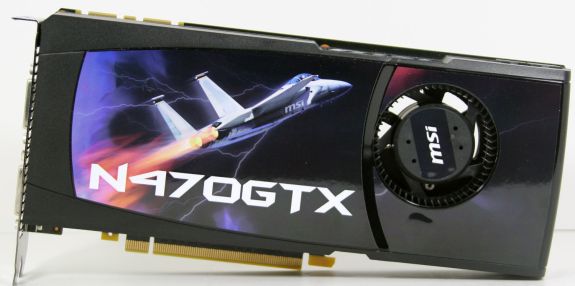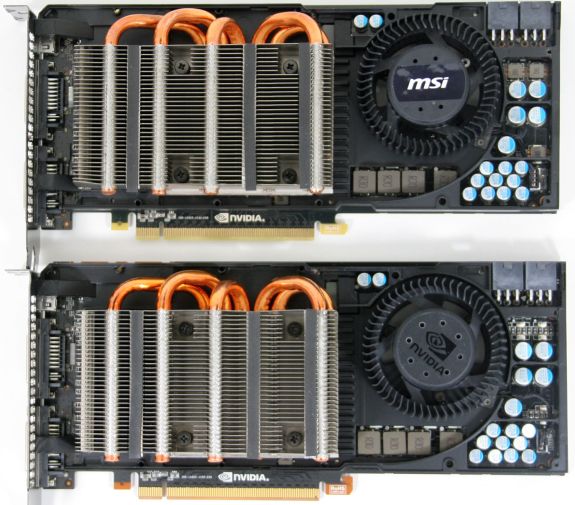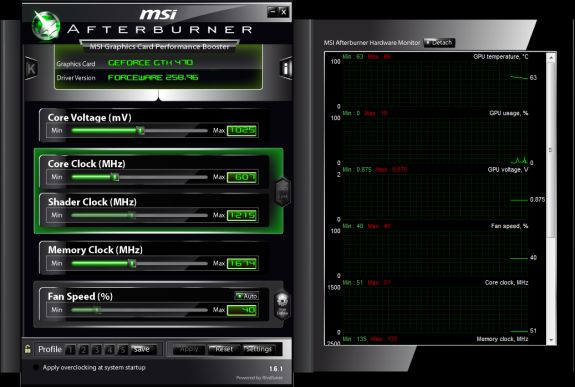MSI’s GeForce N470GTX & GTX 470 SLI
by Ryan Smith on July 30, 2010 1:28 PM ESTFor the launch of the first GF100-based video cards – the GTX 480 and GTX 470 – NVIDIA sent over a 3 card reviewer’s kit containing two GTX 480s and a single GTX 470. This allowed us to do SLI testing with the GTX 480 (a money-is-no-object setup) but not with NVIDIA’s significantly cheaper GTX 470. As part of a comprehensive SLI & CrossFire guide we’re working on for next month we needed a second GTX 470 for testing GTX 470 SLI operation, and MSI answered our call with their N470GTX.
Today we’ll be taking a look at MSI’s GTX 470. We’ll also be taking a sneak-peek of our forthcoming SLI/CF guide with a look at GTX 470 SLI performance.
| GTX 480 | GTX 470 | GTX 465 | GTX 460 1GB | GTX 285 | |
| Stream Processors | 480 | 448 | 352 | 336 | 240 |
| Texture Address / Filtering | 60/60 | 56/56 | 44/44 | 56/56 | 80 / 80 |
| ROPs | 48 | 40 | 32 | 32 | 32 |
| Core Clock | 700MHz | 607MHz | 607MHz | 675MHz | 648MHz |
| Shader Clock | 1401MHz | 1215MHz | 1215MHz | 1350MHz | 1476MHz |
| Memory Clock | 924MHz (3696MHz data rate) GDDR5 | 837MHz (3348MHz data rate) GDDR5 | 802MHz (3208MHz data rate) GDDR5 | 900MHz (3.6GHz data rate) GDDR5 | 1242MHz (2484MHz data rate) GDDR3 |
| Memory Bus Width | 384-bit | 320-bit | 256-bit | 256-bit | 512-bit |
| Frame Buffer | 1.5GB | 1.25GB | 1GB | 1GB | 1GB |
| FP64 | 1/8 FP32 | 1/8 FP32 | 1/8 FP32 | 1/12 FP32 | 1/12 FP32 |
| Transistor Count | 3B | 3B | 3B | 1.95B | 1.4B |
| Manufacturing Process | TSMC 40nm | TSMC 40nm | TSMC 40nm | TSMC 40nm | TSMC 55nm |
| Price Point | $499 | ~$300 | $249 | $229 | N/A |
MSI’s N470GTX is a reference-derived GeForce GTX 470 that’s largely – but not exactly – similar to the reference GTX 470. Clocked at the reference clocks of 607MHz core, 1215MHz shader, and 837MHz (3348MHz data rate) memory, the stock performance of the card is identical to the reference design. This also extends to cooling, where the card uses the reference GTX 470 cooler, and in terms of display capabilities with the card using the NVIDIA-standard 2xDVI + 1x HDMI configuration.
In terms of hardware, the biggest difference is the choice of component selection. MSI advertises this card of being part of their “Military Class” program, signifying that it uses solid state capacitors, chokes, and Hi-c (Tantalum) capacitors where appropriate. In practice the reference design already uses these types of components, however not in the number that MSI does. On our NVIDIA reference card there are a few locations for choke that were left open, whereas MSI has filled these locations with chokes.
With only minor differences for the hardware, the bigger differentiating feature for the N470GTX is the software. As is the case with the rest of their cards, MSI bundles the N470GTX with their dynamic duo of overclocking tools: Afterburner and Kombustor.
Afterburner is MSI’s Rivatuner-based overclocking and monitoring suite, and a wonderful tool altogether. Going beyond straightforward overclocking controls, graphing, and an OSD, the most unique feature in Afterburner is that it offers support for voltage control on most of MSI’s cards, allowing for greater overclocking potential than what can be achieved on stock voltage alone. In the case of the GTX 470, MSI even enables overvolting support on non-MSI cards by allowing overvolting to be used with any reference-alike cards using the same VRMs as the N470GTX. This is a particularly generous move on MSI’s behalf, as it would be trivial to limit this feature to just MSI cards.
Meanwhile Kombustor is MSI’s FurMark-based load testing utility. In practice it’s virtually identical to FurMark, replacing FurMark’s furry donut with a furry version of the MSI logo.
The other significant piece of software included in the package is a voucher from NVIDIA and Capcom for one of 3 Capcom games: Street Fighter IV, Resident Evil 5, or Dark Void. The voucher is in lieu of a specific pack-in title, which is an interesting take on the pack-in game concept. Pack-in games can be hit & miss depending on whether you like the game or not, so a voucher is a much more interesting way to go about things, as it lets the buyer pick from a variety of games. The downside of course is that you’ll need a broadband connection to download the game since it’s delivered purely as a downloadable title rather than having any kind of disc packed-in.

Rounding out the package is the usual collection: a driver/utility CD, a multilingual quick-start guide, 2 molex-to-6pin PCIe power adaptors, a DVI-to-VGA adaptor, and a DVI-to-HDMI adaptor. The warranty on the card is 3 years.
As of this writing, Newegg has the card listed at $299 with a $20 mail-in rebate from MSI. Depending on your feelings towards MIRs, this is either some $30 below the GTX 470 MSRP of $330 a few short weeks ago, or at $280 approaching the price of the cheapest Radeon HD 5850s. NVIDIA and MSI have done a great job of being price competitive here, and as a result the N470GTX is priced only a stone’s throw away from the 5850 while being appreciably faster and including a free game at a time when most 5850s do not.













41 Comments
View All Comments
tech6 - Friday, July 30, 2010 - link
Is it just me getting old or have desktop PC become somewhat boring? There seems to be a lot more sizzle and innovation in mobile, server and even home theater tech.lunarx3dfx - Friday, July 30, 2010 - link
I have to agree, I really miss the days of Overclocking with dip switches and jumpers, and when a 100 MHz OC actually meant performance you could feel and see. It's not as much fun as it used to be. The mobile market, smartphones especially, has gotten very interesting in recent years especially if you have gotten into homebrew and seeing what these devices are really capable of.araczynski - Saturday, July 31, 2010 - link
i wouldn't say boring, just that each new iteration of cards is becoming less and less important.game developers aren't pushing hardware as hard as fast as the manufacturers would want them to.
i've had my 4850's in CF since they came out, and i'm still playing everything at 1080p to this day, granted, i don't use AA, but i never have, so don't care.
dragon age, mass effect 2, star craft 2 all smooth as butter, why am i going to waste time/money with a new video solution?
this is still on my E8600(?) 3.16Ghz C2D. (win7).
people are buying too much into the marketing, so cudos to their marketing departments, or which anandtech is one i suppose.
7Enigma - Monday, August 2, 2010 - link
Hmm...have you checked to see if you are CPU limited in games? I have the same CPU and would guess that at 1080p resolution you could very well be CPU limited at stock E8600 speeds. I have the same proc and it is easy as pie to OC to close to 4GHz. I currently run at 3.65GHz at stock voltage and game at 3.85GHz (again stock voltage) with little more tweaking than upping the frequency (9.5X multi, 385MHz bus). And that's just with an OC'd 4870, dual 5850's surely could use the extra cpu power at such a (relatively) low resolution.HTH
quibbs - Monday, August 2, 2010 - link
In my humble opinion, games drove the PC market into mainstream. It spurred the development of most of the major components. This includes graphics cards. Especially graphic cards. But it seems that game development for the PC, while still major, isn't what it once was. This has to slow down the video card market as the games for PC are less numerous.Perhaps a major breakthrough in gaming (3d, holograms,etc) will continue the card wars, but I think it will eventually head in a different direction. A reversal if you will, energy efficient cards in smaller form factor that are very potent at pushing graphics. Think about it, the cards are getting bigger and more power hungry as they grow in capabilities. At some point this will be unsustainable (in many ways).
Some company will realize that less is more and will produce such a product (when technology permits), and will kick off the new wars.
Just a thought....
piroroadkill - Monday, August 2, 2010 - link
We're getting more and more powerful hardware, but most games are being developed with consoles in mind, so the benefit of having a vastly more powerful machine is very small.I don't feel like I need to upgrade my 4890 and C2D @ 3.4 for gaming, at all. To be honest, my 2900XT didn't really need upgrading, but it ran really hot and started to balls up
softdrinkviking - Monday, August 2, 2010 - link
i don't know what a 2900xt is, but i upgraded from a radeon 3870 because i couldn't play butcher bay or a couple of other titles at my screens native 1920x1200. that was without AA or MSAA or any kind of ambient occlusion or anything, it just couldn't hold the framerates at all.so i got a 5850, and it's been great for everything under the sun. sometimes i can even max out the AA and stuff and the games play fine. (not in crysis)
anyway, the current gen of consoles games can usually take advantage of a regular LCDTV's 1080p, so if i can't play a game at that resolution without any extra visual enhancements selected, that sounds like there is room for improvement.
As for the future of gaming, i personally believe that computers will supplant consoles eventually.
maybe as soon as 15 years?
it's just a guess, i can't back it up, but i personally can't see how sony will be able to afford losing so much money on a new generation console.
if the current generation lasts long enough for sony to take advantage of the, only recently profitable, PS3, then home PCs will have a chance to get much faster and cheaper before a PS4 has time to come to fruition.
it just seems like the consoles will eventually become financially untennable.
damn, my dog just died, gotta go.
afkrotch - Monday, August 2, 2010 - link
All depends on hardware and games. I have to turn down my game settings on Metro 2033. I use a C2D @ 3.3 ghz and a GTS 250. I get way too much framerate drops at 1920x1200 no AA/AF.Granted, I can still play any game out there, so long as I'm willing to lower the quality/resolutions.
arnavvdesai - Friday, July 30, 2010 - link
I just wanted to ask if the author or the staff on AT feel that desktop graphics card are a shrinking market? Is the continued investment by ATi and Nvidia into the development of newer cards seem justified? I own a 5870 and barring a technical fault I dont plan to upgrade for another 3 years as I dont see myself upgrading my monitors.Is the market slowly but surely reducing or am I just wrong in assuming that? If yes, then where should these companies research into?
nafhan - Friday, July 30, 2010 - link
Well, the tech that goes into making a high end card eventually makes it into mobile, low end, integrated, cell phone, and console parts through a combination of cutting down the high end and successive silicon process improvements. So, ATI and Nvidia don't expect to make all their R&D money back from the initial run of high end GPU's. High end GPU's are basically proof of concepts for new technology. They'd certainly like to sell a bunch of them, but mostly they want to make sure the technology works.